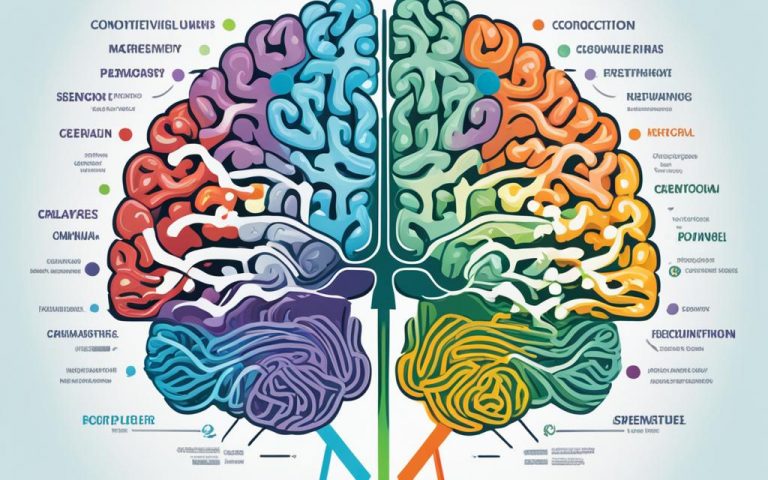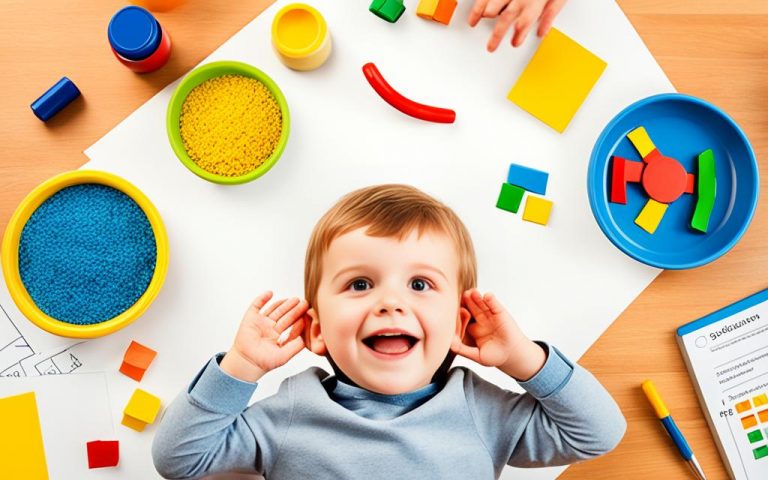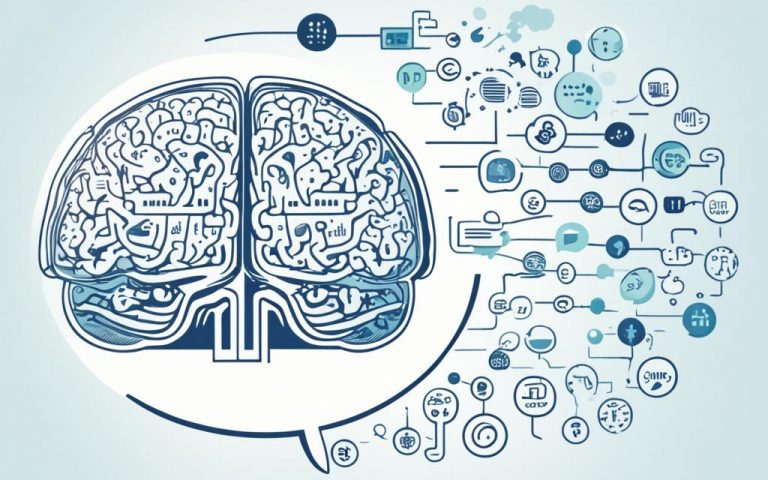Effective Autism Therapy Techniques Explored
Starting to help individuals with autism opens up a world of dedicated therapy methods. It’s crucial to pick treatments for autism that are tailored for each person. This journey allows us to discover various ways to assist those with autism. We aim to provide you with knowledge and tactics for autism therapy. These are created to support people with autism in thriving.
Key Takeaways
- Personalised therapy is critical for addressing the unique needs of those with autism.
- Understanding the spectrum of autism intervention methods can empower caregivers and practitioners.
- Effective treatments for autism are rooted in evidence-based strategies for autism therapy.
- Engaging with the right autism therapy techniques can greatly enhance skill development.
- Continuous advancements in therapy offer new horizons for support and intervention.
Understanding Autism and the Importance of Personalised Therapy
Autism, also known as autism spectrum disorder (ASD), affects people differently. This calls for a deeper understanding autism in its many forms. Traditional approaches often fail because autism is so diverse. That’s why personalised therapy is key for effective treatment.
Personalized therapy for autism focuses on custom interventions. It aims to match methods with an individual’s strengths and needs. This approach embraces flexibility, creativity, and puts the patient at the centre of therapy.
- Comprehensive assessment to identify specific needs
- Customised plans that adapt as individuals grow and change
- Integration of multidisciplinary approaches for holistic development
Research shows the importance of personalized therapy. It leads to better outcomes and improves quality of life. By focusing on more than just symptoms, personalized therapy helps individuals cope with social challenges too.
“Personalised therapy in autism is not just beneficial; it is essential for tapping into each person’s unique profile of abilities and challenges.”
To truly understand autism, one must keep learning about it. Autism is ever-changing. With proper support and personalized therapy, those with autism can reach great heights and live rich lives.
The Role of Behavioural Therapies in Autism Treatment
Behavioural therapies are key in autism treatment due to their specific methods and clear results. They are built on the idea that we can teach and alter behaviour. This gives a strong base for those with autism to grow their social, communication, and thinking skills. We’ll look at three main methods: Applied Behaviour Analysis (ABA), Early Intensive Behavioural Intervention (EIBI), and Positive Behaviour Support (PBS). These have greatly changed the support framework for autism therapies.
Applied Behaviour Analysis (ABA)
Behavioural therapies for autism often start with ABA, a method backed by science. It aims to teach basic skills such as observing, listening, and mimicking. It also covers complex skills like reading, chatting, and seeing things from another’s viewpoint.
Early Intensive Behavioural Intervention (EIBI)
Early Intensive Behavioural Intervention is a branch of ABA best started early. EIBI is a detailed programme that offers 20 to 40 hours of tailored therapy each week. It targets a wide variety of behavioural and development areas in a structured way.
Positive Behaviour Support (PBS)
Unlike methods that just instruct, Positive Behaviour Support focuses on creating a supportive overall environment. It helps those with autism replace difficult behaviours with better ones. This empowers them to live a higher quality of life.
| Therapy Method | Core Principles | Goals | Evidence of Effectiveness |
|---|---|---|---|
| ABA | Incremental learning, positive reinforcement, data-driven decision making | Enhance communication, social interaction, and academic performance | Extensive studies showing significant improvements in adaptive skills |
| EIBI | Early intervention, intensive one-on-one therapy sessions | Accelerate developmental rates and minimise the severity of autism’s core features | Longitudinal studies suggest improvements in IQ and language skills |
| PBS | Functional assessment of behaviours, proactive strategy | Encourage a positive social behaviour and reduce challenging behaviours | Case studies indicate reduced disruptive behaviours and increased social engagement |
Learning about these behavioural therapies gives you insight into some of the most powerful changes in autism treatment. Each method is unique, but they all share a goal. They aim to better the lives of individuals with autism.
Autism Therapy Techniques: Strengthening Communication Skills
Communication is key in how we connect with each other. For those with autism, communication skills therapy is crucial. It helps them share their thoughts and grasp what others say. It’s not just about language rules. It’s about a range of strategies aimed at better connection and understanding.
At the heart of autism and language development lies alternative and augmentative communication (AAC). AAC is vital for individuals who find verbal communication tough. It could be picture systems or advanced electronic devices. AAC gives a voice to those who might find speaking hard.
Improving communication in autism goes beyond just speaking. It’s about realizing the importance of one’s voice for a full and independent life.
Below is a table of key techniques in autism communication therapy. They help with language growth and better communication.
| Technique | Description | Benefits |
|---|---|---|
| Sign Language | Use of hand signs and gestures as a form of communication | Reduces frustration from inability to verbalise, encourages gestural communication |
| Picture Exchange Communication System (PECS) | Exchange of pictures to communicate wants and needs | Increases spontaneous communication, accessible for nonverbal individuals |
| Speech Generating Devices (SGDs) | Electronic devices that produce speech through text or symbol input | Allows for complex expression, can be customised for the individual |
| Social Stories | Short, descriptive stories that depict social situations and appropriate responses | Improves understanding of social cues, ideal for pre-teaching scenarios |
| Joint Attention Therapy | Fostering the ability to share focus on an item or event with another person | Foundational for language development, enhances engagement and learning |
| Vocal Exercise Programs | Structured exercises to improve vocal quality and speech articulation | Boosts speech clarity, aids in verbal communication |
Exploring these techniques, remember, success in communication skills therapy for autism needs patience, consistency, and understanding the person’s needs.
The aim is to create a space where those with autism are heard and can express themselves fully to the world.
Integrating Educational Interventions for Enhanced Learning
Educating students with autism is changing fast, focusing on unique learning needs. Practices like TEACCH, personalised lessons, and mixed classes help. These methods aim to make learning possible, fun, and meaningful for students with autism.
Structured Teaching with TEACCH
The TEACCH program started at the University of North Carolina. It uses structured teaching to help students with autism. A predictable setting helps ease anxiety and improve understanding. TEACCH organises spaces and activities clearly, helping students work more independently.
Individualised Education Programmes (IEPs)
IEPs are tailor-made for each student’s particular needs and strengths. Teachers, parents, therapists, and sometimes students create these plans together. They set goals for both school subjects and life skills, readying students with autism for the future.
Inclusive Classrooms and Peer-mediated Instruction
In mixed classrooms, students with autism learn with others. This setup uses normal social behaviour as learning examples. Peer-guided learning helps with social skills and academic work. It builds respect, understanding, and friendships among all students.
Sensory Processing Techniques for Children with Autism
To help a child with autism, it’s key to get sensory issues. Sensory integration therapy is a method that can help them engage with the world better. This therapy isn’t just about sensory issues. It also helps with learning, social skills, and everyday tasks.
Some kids may be very sensitive to sound, light, or touch, while others may seek out more sensory input. Tailored sensory techniques are crucial here. They provide a way to help each child with their specific sensory challenges.
Sensory integration therapy often involves an occupational therapist skilled in autism sensory challenges. They create a safe space for kids to try out sensory activities. This helps children with autism get used to sensations that used to upset them.
Sensory integration therapy helps children with autism process sensory information better. This means they can take part in daily activities more easily and with confidence.
The table below shows some activities used in sensory integration therapy and their goals:
| Therapeutic Activity | Goal of the Activity | Benefit for Children with Autism |
|---|---|---|
| Swinging | Improve vestibular processing | Increases tolerance to movement; enhances balance and spatial orientation |
| Deep Pressure Therapy | Offer proprioceptive input | Induces calming effect; helps regulate emotional responses |
| Textured Touch | Expand tactile discrimination | Reduces tactile defensiveness; encourages exploration and tactile learning |
| Scent Exploration | Raise olfactory awareness | Decreases sensitivity to smells; can be used to transition reticence to specific foods |
| Listening Therapy | Strengthen auditory processing | Promotes concentration; improves tolerance to sound and ability to follow verbal commands |
Making sensory techniques part of a child’s daily life is crucial. Sensory integration therapy needs to change as a child grows. Parents, teachers, and therapists working together can bring big improvements. This can make life better for kids with autism.
Social Skills and Autism: Nurturing Peer Relationships
People with autism can find making friends quite hard. Training in social skills helps them reach out and make connections. With tools like social stories and scripting, being part of social skills groups, and doing role-play, they can get better at socialising.
Social Stories and Scripting
Using social stories and scripting has changed how people with autism learn to interact. These stories help them understand what behaviour is expected in different situations. It’s like practicing for real-life conversations.
Social Skills Groups
In social skills groups, people with autism can practice talking to others in a safe space. This setup lets them learn from each other, boosting their confidence and understanding of social rules.
Role-Playing and Modelling for Autism
With role-playing and modelling, they watch and repeat social behaviour. This way, they learn from what they see, grasping how to communicate and build relationships.
Figuring out which method suits someone best can be a bit tricky. The table below shows what these methods are good for. This makes it easier to compare their advantages:
| Technique | Description | Key Benefits |
|---|---|---|
| Social Stories and Scripting | Custom narratives related to specific social situations. | Enhances prediction of outcomes and understanding of social expectations. |
| Social Skills Groups | Facilitated group sessions focusing on social skill development. | Promotes peer interaction and cooperative learning. |
| Role-Playing and Modelling | Imitation of social interactions with guidance and correction. | Facilitates understanding of complex social cues and appropriate responses. |
By understanding these methods, training in social skills can become an adventure. It’s important to try each one to see what fits your needs the best.
Strategies for Autism Therapy: Engaging Through Play
In autism therapy, play therapy for autism has become quite important. It helps to unlock new paths for growth. For those on the spectrum, play allows them to communicate and learn in a familiar and fun way.
Play isn’t just for fun; it’s a key learning tool. It helps improve social skills, emotional control, and flexible thinking. These skills are crucial for solving problems in the real world.
- Cognitive Development: Through play, children with autism can explore concepts like cause and effect, sequencing, and problem-solving in a low-stress, engaging environment.
- Language Skills: Role-play and storytelling within the play allow children to practice language and communication in a setting that’s less intimidating than direct conversation.
- Social Interaction: Play sets the stage for interaction with peers and adults, nurturing the social skills that are essential for building relationships.
- Sensory Integration: Sensory play activities are particularly valuable, helping children to process sensory inputs more effectively.
Therapeutic play for autism is special because it’s tailored to each child. Activities are adjusted for their needs, interests, and level of development. While all kids play, how it’s used in therapy varies with each child.
By harnessing the transformative power of play, you’re not simply teaching a child; you’re giving them the space to discover, to experience joy, and to learn in the most natural way possible.
Play can have a huge effect on children with autism. Using play in therapy brings joy and opens up many learning opportunities. Every game and laugh is a step forward in their growth.
Autism Therapy Techniques: A Comprehensive Approach
A broad approach to autism therapy proves to be the most potent. It focuses on being inclusive, working as a team, and using advanced tech. This way, it meets the varied needs of people with autism well.

Multidisciplinary Teams and Holistic Support
At the heart of this broad method are diverse teams. These teams include experts from psychology, occupational therapy, and education. Together, they create and apply a plan that helps with communication, behaviour, and sensory issues. This means individuals with autism get support in all areas of their growth.
Parental Involvement and Family Therapy
Parental involvement is key in this comprehensive therapy plan. Families get tips and ways to help their child’s growth at home. This backs up what the child learns in therapy sessions. Also, family therapy helps everyone understand and cope with autism. It makes the whole family’s life better.
Technological Aids in Autism Therapy
Using tech in autism therapy is growing. It offers new ways to engage those with autism. Things like communication tools and learning apps tailor learning and help individuals express themselves. This opens new doors for them to connect with their surroundings.
Conclusion
This exploration into effective autism therapy highlights how special strategies improve lives. Tailoring therapy helps with communication, sensory processing, and social skills. Techniques like Applied Behaviour Analysis and Positive Behaviour Support are key. They work alongside educational methods such as TEACCH and inclusive classes. This personalisation helps unlock growth and learning.
Play is important in therapy, blending fun with skill building. The support of families and using technology are crucial for a complete approach. As we conclude, let’s celebrate the progress in treatment methods. They offer hope to many families.
This article summarised autism therapy techniques. But, the work to improve therapy is never done. Keep up with new research and provide compassionate care. Remember, it’s crucial to create environments where everyone can thrive to their full potential.
FAQ
What are some effective autism therapy techniques?
Effective autism therapy techniques involve Applied Behavior Analysis (ABA) and Early Intensive Behavioral Intervention (EIBI). They also include Positive Behavior Support (PBS) and communication skills therapy. Additionally, sensory processing techniques, social skills training, and play therapy are beneficial.
What are the different treatments for autism?
The treatments for autism cover behavioral therapies like ABA, EIBI, and PBS. Communication skills therapy and educational interventions are also key. This includes strategies like Structured Teaching with TEACCH and Individualized Education Programs. Furthermore, sensory processing techniques, social skills training, and play therapy play a vital role.
How do behavioral therapies help in the treatment of autism?
Behavioral therapies, such as ABA, EIBI, and PBS, focus on improving behavior and skill development. They use proven techniques to teach new skills. These therapies also reduce challenging behaviors and boost social and communication skills.
What is communication skills therapy for autism?
Communication skills therapy for autism aims to improve communication abilities. It works on developing language and speech skills. The therapy also boosts non-verbal communication and promotes social interaction using various strategies.
How can sensory processing techniques help children with autism?
Sensory processing techniques address the sensory challenges faced by children with autism. They aim to improve sensory integration and regulation. This helps individuals with autism process sensory information better, leading to improved behavior and function.
What is social skills training for autism?
Social skills training for autism teaches individuals the skills needed for effective interaction and communication with others. It often involves social stories, scripting, and participation in social skills groups. Role-playing and modeling are also used to enhance social interactions.







